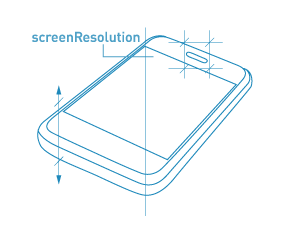 The stats on the most popular viewport sizes are particularly important for web designers who must take this data into consideration before making any decisions on the website design. Here at DeviceAtlas we know the characteristics of the most used phones today including their screen sizes, screen resolutions, and other features. Check out the latest statistics that will help you design websites in 2016.
The stats on the most popular viewport sizes are particularly important for web designers who must take this data into consideration before making any decisions on the website design. Here at DeviceAtlas we know the characteristics of the most used phones today including their screen sizes, screen resolutions, and other features. Check out the latest statistics that will help you design websites in 2016.
Touchscreen and non-touchscreen phones
Touchscreen phones have become widely popular with the development of the capacitive technology which makes it possible to use a smartphone without a stylus. Some early examples include the likes of LG Prada, T-Mobile G1 and, most importantly, the iPhone. Apple’s touchscreen technology was clearly ahead of its time especially in terms of the convenient virtual keyboard which other manufacturers struggled to create.
As a consequence of these developments, today the majority of phones are equipped with a touchscreen even in the lowest price categories. 'Non-touch' phones are used for web browsing only in some countries. Here are 10 countries where non-touchscreen phones generate a significant share of mobile traffic.
| Country | Traffic from non-touch phones |
|---|---|
| South Africa | 11.24% |
| Kenya | 8.81% |
| Indonesia | 8.71% |
| Ghana | 6.9% |
| Bangladesh | 4.45% |
| Ukraine | 3.96% |
| Nigeria | 2.83% |
| India | 2.64% |
| Israel | 1.98% |
| Pakistan | 1.8% |
Diagonal screen size
4in and 4.7in were the two most popular diagonal screen sizes in Q4 2015 in many countries which is obviously caused by the popularity of iPhone 5/5S and iPhone 6/6S. The majority of devices released in 2015 were 5in or larger, while smaller devices were mainly in low- and mid-range price categories, for example Motorola Moto E or Samsung Galaxy J2. The only notable exceptions were iPhone 6S (4.7in) and Sony Xperia Z5 Compact (4.6in).
Physical screen resolution
Many new phones released in 2015 featured a Full HD resolution, even in mid-range price categories. Some flagship phones, such as Samsung Galaxy S6, Samsung Galaxy Note 5, Sony Xperia Z5 Premium, featured a qHD (1440 x 2560) screen resolution. Again the iPhone was an exception with the 750 x 1334 (6S) and 1080 x 1920 px (6S Plus) screen resolutions.
Here are the latest statistics for Q4 2015 on the most popular physical screen resolutions (specified by manufacturers) based on DeviceAtlas data.
Virtual pixel screen resolution
The viewport size is the area of a website visible on a given screen. It depends on the number of virtual pixels on the screen also known as CSS pixels. One CSS pixel equals 1/96th of 1 inch. Its relation to physical pixels, provided by the phone maker, depends on the device. For example for a low-dpi phone 1px can equal one device pixel of the display, while for some high resolution screens 1px can equal more than 1 device pixel.
Getting to know the statistics on the most popular virtual pixel screen resolutions helps designers create websites that better fit the user's screen. Check out the latest stats for Q4 2015.



